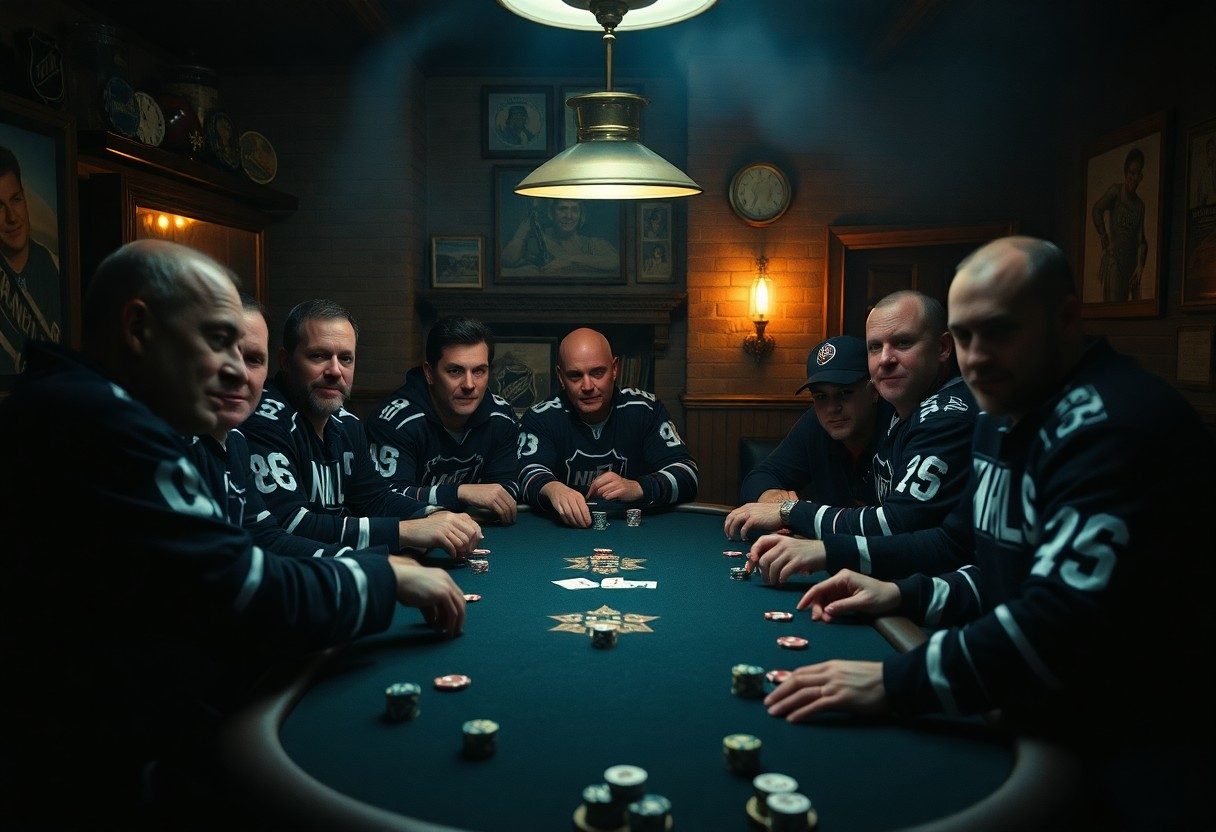Poker is not just a game of chance; it’s an intricate battle of psychology, strategy, and decision-making that can provide valuable insights for hockey players. By adopting poker strategies, you can enhance your mental fortitude, improve your in-game decisions, and gain a competitive edge on the ice. This guide will explore how principles from poker, such as risk assessment, reading opponents, and maintaining composure, can help you elevate your performance in hockey. Get ready to unlock a new level of your game by integrating these powerful mental techniques.

Types of Poker Strategies
While poker strategies can vary widely, they can be primarily classified into a few key types that you can apply to enhance your game in hockey. Understanding these strategies allows you to adapt and refine your style based on your opponents and the game dynamics. Here are some common categories:
- Aggressive Play
- Defensive Play
- Bluffing
- Value Betting
- Position Play
Any successful hockey player can draw valuable lessons from these strategies to gain an edge over opponents.
| Strategy Type | Description |
|---|---|
| Aggressive Play | Taking charge of the game by betting high and forcing opponents to make tough decisions. |
| Defensive Play | Playing it safe to protect your position, minimizing risks while waiting for better opportunities. |
| Bluffing | Misleading your opponents about your hand strength to induce errors. |
| Value Betting | Playing hands strategically to maximize gains from strong positions. |
| Position Play | Using your seating position at the table to control the action. |
Aggressive Play
Types of aggressive play involve taking calculated risks to put pressure on your opponents. In hockey, you can mirror this approach by leading offensive plays, making bold passes, or taking shots when the opportunity arises. This proactive mindset keeps your opponents on their toes and can create scoring chances, just like in poker, where showing strength often forces others to fold.
Defensive Play
On the other hand, defensive play focuses on safeguarding your position while waiting for the right moment to act. In hockey, this means playing conservatively, ensuring you minimize mistakes while assessing your opponent’s strengths and weaknesses. Strong defensive strategies allow you to counter aggressive plays effectively, much like a poker player who waits for the optimum hand before making a significant move.
With a solid understanding of defensive play, you can learn to anticipate your opponents and react accordingly. This mindset not only preserves your current position but also allows you to capitalize on their mistakes. By leveraging defensive strategies in hockey, you ensure that you can execute key plays effectively when the timing is right, much like evaluating your hand in poker before going all-in.
Key Factors for Success
One of the key factors for success in combining poker strategies with hockey skills lies in the mental aspects of the game. Focus on these important elements:
- Leveraging psychological tactics
- Maintaining composure in adversity
- Embracing uncertainty and risk
- Developing strategic thinking
- Building strong observational skills
The integration of these factors can elevate your performance on the ice.
Decision-Making Under Pressure
Under significant pressure, you often find your decision-making skills put to the test. In poker, players constantly evaluate their options based on limited information, much like in hockey when you need to make quick plays. By developing your mental agility, you enhance your ability to analyze situations rapidly, allowing you to make informed choices even in high-stress moments.
Reading the Opponent
One of the fundamental skills in both poker and hockey is the ability to read your opponent. This entails observing their movements, tendencies, and body language to predict their next move. By understanding their strategy and motivations, you can anticipate plays and position yourself advantageously. The insight gained from analyzing your opponent’s behavior can lead to critical advantages during gameplay.
Success in reading the opponent requires keen observation skills and a deep understanding of their patterns. As you study their strategies, you can identify weaknesses and exploit them to your advantage. By translating your poker skills of assessing opponents into hockey, you’ll be better equipped to outsmart your rivals and enhance your game performance.
The Mental Edge: Step-by-Step Application to Hockey
Once again, you can leverage poker strategies to enhance your hockey performance. By understanding game dynamics through strategic analysis and focused implementation, you can elevate your gameplay. Below is a structured approach to integrate these principles into your hockey strategy:
| Focus | Identify key moments in the game where strategic decision-making is paramount. |
| Adaptation | Adjust your gameplay based on the opponents’ tendencies and your observations. |
| Risk Management | Evaluate your choices carefully, weighing potential gains against risks. |
| Emotional Control | Maintain composure during high-pressure situations to stay decisive. |
Analyzing Game Situations
On the ice, your ability to analyze game situations is vital. Use your observations to recognize patterns and tendencies in both your play and that of your opponents. By studying how specific situations unfold, you can anticipate your opponent’s moves and make informed decisions to gain an upper hand during the game.
Implementing Strategies During Play
During gameplay, apply the strategies you’ve developed by focusing on execution. Quick decisions are often necessary, so intuitively integrate your poker skills into your hockey. Use your understanding of probability and risk assessment to inform your actions in real-time, whether you’re on offense or defense.
A successful implementation of these strategies relies on your training, awareness, and adaptability. Practice situational drills that mimic high-stakes scenarios, allowing you to refine your reactions and decision-making. The more skillfully you merge these tactics into your hockey game, the greater your ability to respond effectively under pressure and make critical plays when it matters most.
Benefits of Applying Poker Strategies in Hockey
Not only does the mental edge gained from poker strategies enhance your gameplay, but it also provides significant advantages in teamwork and strategy implementation on the ice. By integrating these techniques, you can better anticipate opponents’ moves, improve decision-making under pressure, and foster a more strategic approach to the game. This unique perspective will empower you to elevate your performance while contributing to your team’s overall dynamic.
Enhanced Mental Toughness
Benefits derived from poker include the development of key mental toughness skills, which are imperative for effective gameplay. Applying poker strategies allows you to build resilience against pressure, improve focus during critical moments, and cultivate a calm demeanor, all of which can significantly enhance your performance on the ice.
Improved Game Awareness
Now, as you adopt poker strategies, you will notice a significant enhancement in your game awareness. Your ability to read the game, analyze situations, and predict opponents’ next moves will sharpen, ultimately informing better decisions throughout the match.
Game awareness is not just about being present; it’s about actively understanding and anticipating plays as they unfold. By observing player tendencies and patterns, you’ll become more adept at recognizing when to take risks or play it safe. This situational awareness mirrors the thought process in poker, where successful players must gauge their opponents’ potential actions. As a result, you’re equipped to better maneuver through various situations, positioning yourself for success and adapting your strategies on-the-fly during the game.
Tips for Hockey Players
Many hockey players can enhance their game by adopting poker-inspired strategies. Consider the following tips to gain your mental edge on the ice:
- Stay composed under pressure.
- Anticipate your opponent’s moves.
- Make calculated risks.
- Focus on long-term goals.
Knowing how to implement these strategies can significantly influence your performance and decision-making abilities.
Practicing Patience and Discipline
While the intensity of hockey may tempt you to rush decisions, practicing patience enables you to analyze plays more effectively. This quality allows for better positioning and timing when executing plays, ensuring that you make choices that enhance your team’s success rather than hinder it.
Developing a Tactical Mindset
On the ice, having a tactical mindset can set you apart from your opponents. This approach involves assessing the game from multiple perspectives and anticipating various outcomes based on your actions and those of others.
To enhance your tactical mindset, evaluate each game as a unique puzzle where each piece has its place. Think strategically about your positioning and how it affects your teammates and opponents alike. Constantly analyze scenarios and learn to shift your approach based on the game’s flow. This adaptation will sharpen your decision-making skills, enabling you to execute plays that can lead your team to victory.
Pros and Cons of Adopting Poker Strategies
All poker strategies can offer both advantages and drawbacks for hockey players. Understanding the balance between these elements is imperative for effective application. Below is a breakdown of the pros and cons of integrating poker strategies into your approach.
| Pros | Cons |
|---|---|
| Enhances decision-making skills | Risk of overthinking during play |
| Teaches risk management | May distract from fundamental skills |
| Improves psychological resilience | Can lead to misreading opponents |
| Encourages strategic thinking | Potential to become overly aggressive |
| Promotes adaptability in various situations | May require significant practice to master |
Advantages in Competitive Play
With the competitive nature of hockey, implementing poker strategies can significantly improve your game. Skills such as mindful decision-making and strategic planning can help you make better choices under pressure. You can leverage these insights to create plays that outsmart opponents while also managing your own emotional state, allowing for a more focused performance on the ice.
Potential Risks and Misapplications
Adopting poker strategies comes with potential risks that can undermine your performance. Misapplying these strategies might lead to confusion during gameplay, as you might overanalyze situations instead of relying on your instincts and foundational skills.
Pros of integrating poker strategies include an increased awareness of game dynamics and improved awareness of your surroundings. However, if you focus too much on bluffing or strategic mind games, you might overlook the fundamentals of teamwork and communication, imperative elements in hockey. It’s important to strike the right balance to maintain effectiveness on the ice while still gaining the mental edge from poker principles.
Final Words
Ultimately, integrating poker strategies into your hockey training can provide you with a distinct mental edge on the ice. By learning to read opponents, manage emotions, and make strategic decisions under pressure, you can enhance your gameplay significantly. Adopting these skills not only improves your performance but also boosts your confidence in high-stakes situations. Embrace these techniques to elevate your game and stay ahead of the competition.













